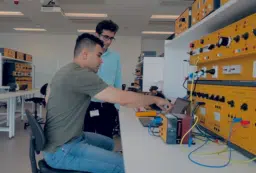New home builders and those looking to change their gardens may soon have the opportunity to visualise the changes in advance, using new technology that combines reality with computer generated virtual objects.
By wearing special goggles and a backpack computer, people can walk around outdoors and see the real world as it currently is. They can then add new imagined features, and try out ideas such as putting in a new house or garden features such as a row of trees or a pool.
The Tinmith system was developed by Wayne Piekarski. He said that the newly added virtual objects can also be “moved” around the landscape by a viewer wearing special metallic gloves attached to the computer.
“What people see through the goggles is a combination of the existing landscape and the new added features,” Mr Piekarski said. “It makes real the things that were previously only fantasy in movies such as Minority Report and The Lawnmower Man.”
The helmet used in Tinmith provides augmented reality, and uses a set of special goggles that allow wearers to see the real world as well as artificial computer graphics. The backpack contains a computer and other equipment such as GPS (Global Positioning System).
“The applications are endless. This device could be used in surveying, mining, forestry, search and rescue and entertainment, as well as building construction and landscape design,” Mr Piekarski said.
Tinmith is one of the most advanced outdoor augmented reality systems in the world, and Mr Piekarski and his supervisor Dr Bruce Thomas are regarded as world experts in the field.
While the current backpack is a large and expensive prototype, Mr Piekarski expects the unit to shrink dramatically in cost and size if it is commercially produced in large quantities.
“By being able to see things in the real world before they are built, people can much more easily understand information. Looking at plans on paper or a computer monitor is difficult for most of us,” he said.
“Augmented reality tricks your brain into thinking the virtual objects are really there.”
The backpack is available for demonstrations and video opportunities if required.
On Tuesday and Wednesday Wayne will be presenting his work to the public at the Great Australian Science Show at the Melbourne Museum along with 15 other Fresh Scientists selected from over 100 nominations.
Wayne Piekarski
Researcher / Lecturer University of South Australia, School of Computer & Info Science
Backpacking Scientist Rearranges The World Using Augmented Reality
Tinmith Mobile Outdoor Augmented Reality Project
Using a computer worn on the back and a set of virtual reality goggles, a user can walk around the outdoor environment and experience augmented reality. The user can see computer generated artificial trees, buildings, and other structures as if they existed in the real world. The user can edit these environments using hand gestures and special digital gloves.
Project description
This project was developed as part of my PhD thesis research at the University of South Australia. The main topic of the research was the development of interaction techniques for 3D modelling of large structures in outdoor augmented reality environments. Augmented reality is the process of adding computer generated graphics over a user’s view of the physical world. These graphics appear to the user as being a part of the normal real world, and when using a mobile computer, can be experienced outdoors while the user moves around. Augmented reality and mobile computers have a number of previously unsolved challenges that were addressed in my PhD thesis.
As part of my PhD thesis, I developed a backpack computer, software, and techniques that allow users to go outside and perform augmented reality modelling. The user puts on the backpack, gloves, and helmet, and then turns on the power. Through the helmet, the user can see the real world with some computer generated text floating on the display. The gloves allow the placement of 3D objects such as trees, tables, and people. The user can walk around and view these objects from anywhere in the world and the computer will draw these objects correctly over the normally viewed environment. The gloves allow the user to select and move these objects, editing the environment that is around them in real time. This demonstration has potential uses for landscape and environmental designers, who would like to see what a design would look like before physically constructing it.
A more powerful example is the modelling of arbitrary structures outdoors such as buildings, trees, and ground features. Using the gloves, the user can use their hands to place down walls and carve out 3D surfaces, even when the object is out of arms reach or partially concealed by obstructing objects. The user can perform this modelling process repeatedly until the object is of the desired shape and texture. The models can be shared with other wearable and indoor users via wireless Internet, or saved for future use. These models can also be previewed and then potentially turned into plans by an architect for physical construction. While my PhD thesis focussed on the more technical challenges, in the future I am planning to explore useful applications for the technology.
Personal details
Qualifications: Doctor of Philosophy – University of South Australia (Currently submitted for examination in June 2003); Bachelor of Engineering in Computer Systems Engineering – University of South Australia (First Class Honours) D1-07 Wearable Computer Lab, School of Computer and Information Science, University of South Australia




 Fresh Science is on hold for 2022. We will be back in 2023.
Fresh Science is on hold for 2022. We will be back in 2023.